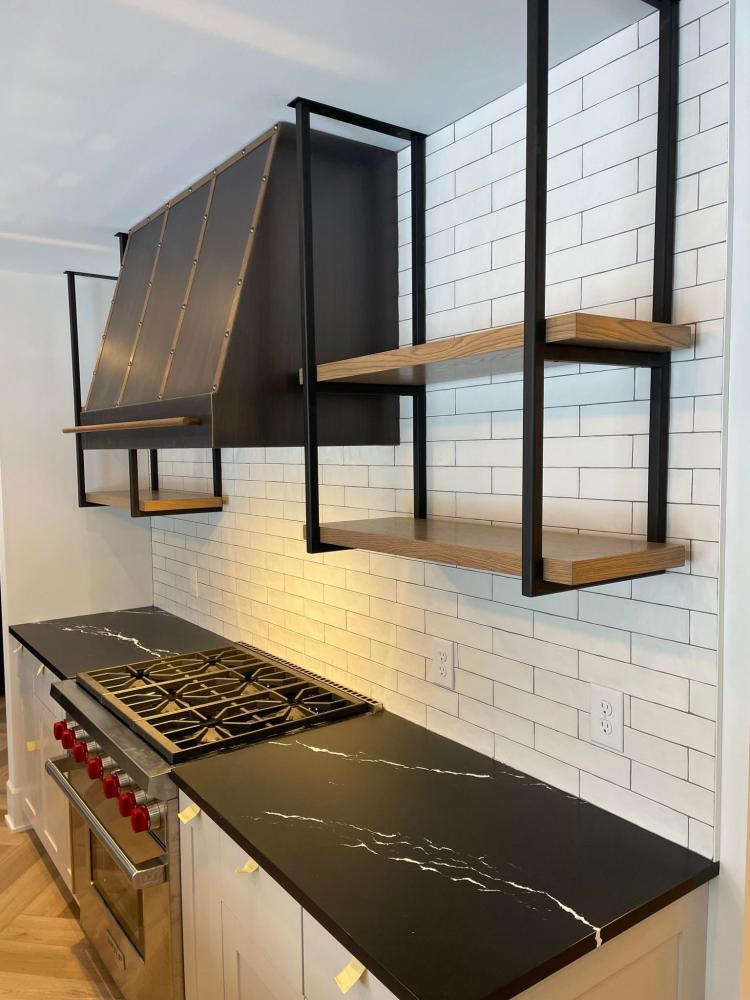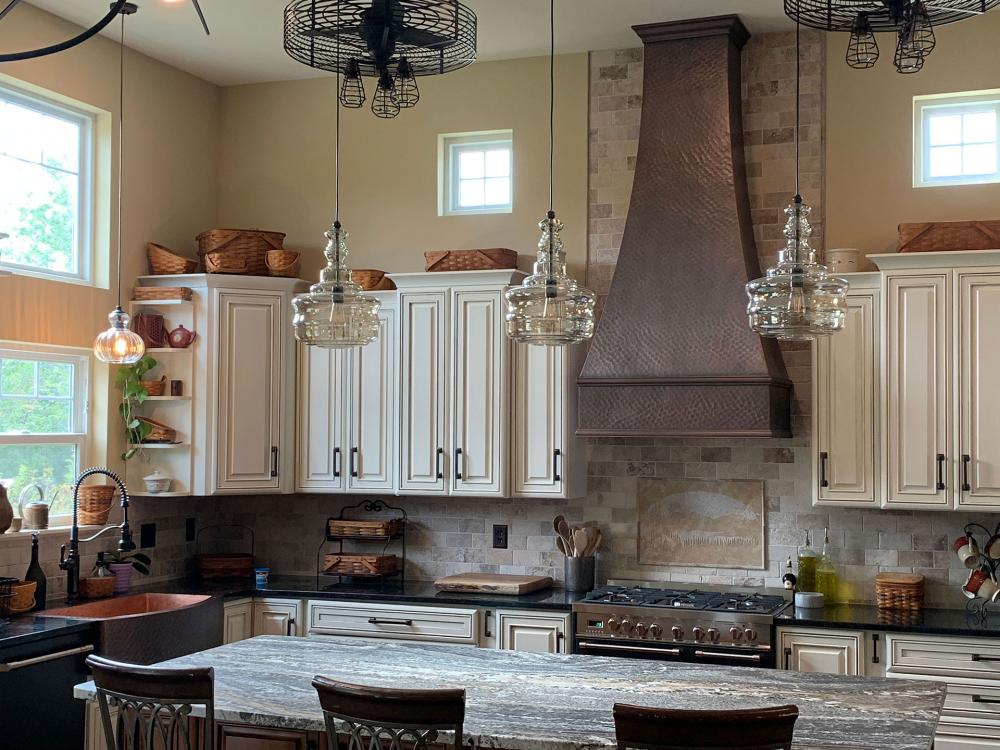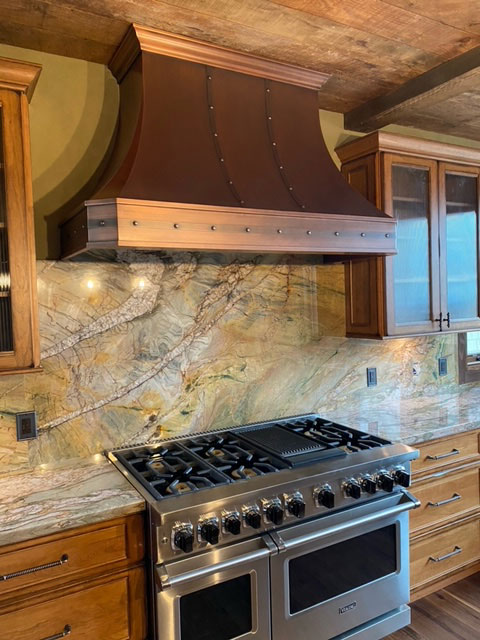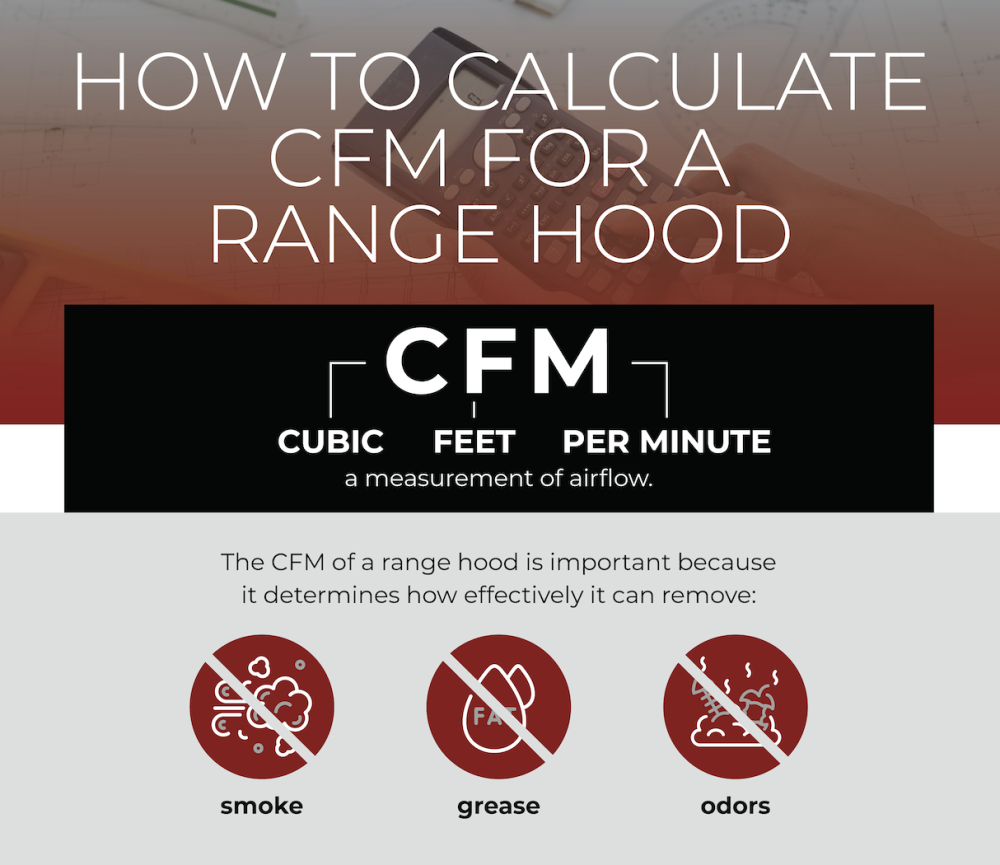
"How many CFM should my kitchen's exhaust fan have?" is a question on the minds of many cooks and contractors alike.
Knowing the CFM for your kitchen exhaust fan is important because it ensures that you get the right range hood with power to provide adequate ventilation in the kitchen and eliminate unhealthy smoke and smells caused by cooking. This is called indoor pollution and can be associated with health risks.
CFM stands for cubic feet per minute. It measures the volume of air moved over a certain period of time. One way to think about it is if you were to fill a room with fresh air over a certain amount of time, how long would it take?
If you know the size of the room and the rate at which you want to introduce new air into the room, then you can calculate the number of cubic feet of air needed to achieve this goal.
And while many people think that bigger vents mean better ventilation, that isn't always true. In fact, the size of your kitchen exhaust fan doesn't really matter all that much. The amount of airflow that it moves around is what counts.
If you've ever wondered how to calculate CFM for kitchen exhaust fans, you've come to the perfect place. We'll begin by examining the variables that affect CFM. We'll also consider why your gas stove and electric stoves may need exhausts with different CFMs.
Factors to Consider When Calculating CFM for Kitchen Exhaust Fans
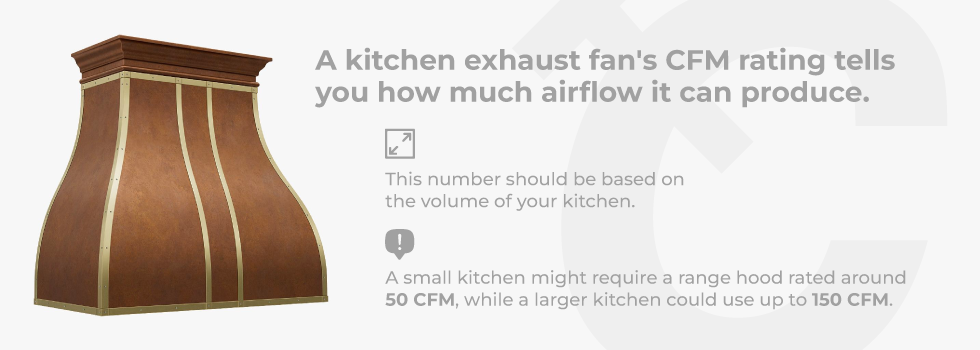
A kitchen exhaust fan's CFM rating tells you how much airflow it can produce. This number should be based on the volume of your kitchen.
The most important consideration when determining the CFM exhaust size is the room where it would be used. For example, a small kitchen might require a range hood rated around 50 CFM, while a larger kitchen could use up to 150 CFM.
The American Society of Heating, Refrigeration and Air Conditioning Engineers (ASHRAE) is the leading authority behind how CFM ratings are measured. These ratings measure air movement by calculating the pressure difference across a fan blade. A higher CFM means more airflow.
You can find the CFM rating for a range hood or other kitchen exhaust fan by looking at its nameplate or label. You can also check online to see if the manufacturer has published a specific CFM value.
Now, let's look at some of the important factors you'll need to consider when determining the CFM for your kitchen exhaust.
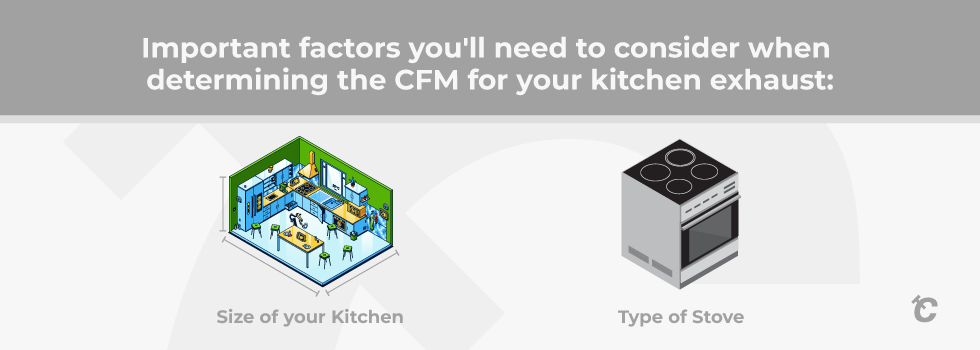
Size of your kitchen
Knowing the size of your kitchen will help you decide how many CFM your exhaust fan needs. An exhaust fan that delivers too little airflow could cause smoke or grease to accumulate inside the ductwork. This buildup could lead to expensive repairs later.
If you cook for one person and have a small kitchen, you probably need a small range hood. But, if you have a large kitchen and cook for multiple people, you probably need a large exhaust ventilation system.
So, based on the kitchen's volume, you can determine the recommended CFM.
To determine the total volume of your kitchen you can use the following formula:
- Volume = Height x Width x Depth
For example, a 10-foot by 12-foot by 8-foot room has an approximate volume of 960 cubic feet.
Once you have the room's total volume, you can figure out the CFM needed for your kitchen exhaust fan using the calculations below. First, let's look at some other factors involved in calculating your CFM.
Type of stove
The CFM needed for exhaust fans differs depending on the type of stove you use because different types of stoves generate different amounts of heat.
For example, gas ranges tend to create more heat than electric ones. Therefore, an exhaust fan designed for an electric range may not work well when used with a gas stove.
You also need to consider whether your stove has a built-in oven. Some models include both a stovetop cooking surface and an oven. These units usually have their own exhaust system.
If you have a gas stove, you should also think about how much heat the burners produce. The more heat produced, the higher the CFM requirement.
If you have an electric stove, you don't need to worry about the heat output because all the electricity goes into heating up the elements. You only need to consider the size of the stovetop.
Gas stove
When calculating the CFM for a kitchen exhaust when using a gas stove you must take into account the heat output of the burner.
The heat output of a gas stove is measured in BTU. To power your range hood, you need at least 100 CFM for every 10,000 BTUs of your stovetop.
So to calculate the minimum CFM needed for a gas stove, add the BTU output of each burner and divide that by 100.
If you have four burners that produce 10,000 BTU each, then your total BTUs for the entire stove top is 40,000. 40K divided by 100 equals 400CFM. So, you’ll need a range hood that produces at least 400CFM of airflow.
To be safe, when in doubt, go with a higher CFM, as gas burners produce more concentrated fumes.
Electric stove
Calculating the CFM for kitchen exhausts when using an electric stove, is really quite simple. There’s no need to go over complicated math, and unlike a gas stove, you don't need to worry about the heat output.
All you have to do is to find the stove width (measured by linear foot), multiply it by ten, and add a few inches to the height of the range. This will give you the minimum CFM rangehood required, according to the manufacturer.
Cubic feet per minute
As mentioned above, cubic feet per minute is a measurement used to describe airflow. The number represents the volume of air moved through a given space every minute.
To calculate CFM, multiply cubic feet by 60 seconds. So, for example, a fan moving 1 cubic foot of air per second would be equal to 120 CFM.
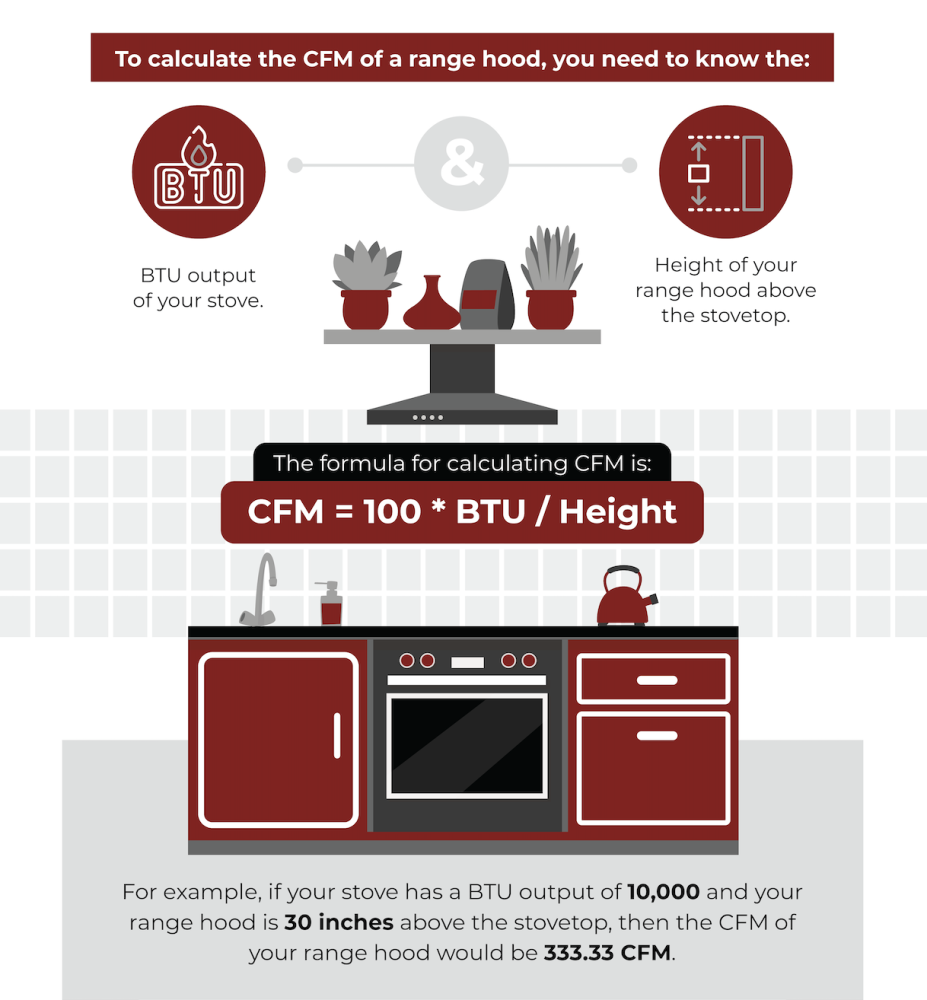
The Calculation
So, to sum that all up, let's look at the simple calculation you can use to determine the minimum CFM for your kitchen exhaust.
- Calculate the volume of your kitchen.
- As a general rule, the fan needs to exchange the air at least 15 times per hour, so multiply the volume of your kitchen by 15.
- Divide your number by 60, giving you the minimum cubic feet per minute for your exhaust fan.
Is It Better to Have a Higher CFM?
While a higher CFM is generally better, it's not always necessary. When selecting the best kitchen exhaust fan for your needs, you should take other variables into account. Some of these variables include:
- Noise level – Does the fan create too much noise?
- Cost – Are you willing to pay extra for quietness?
- Energy efficiency – Larger fans use more power and produce more noise. But they may be able to push more air through a space at once.
So, if you're looking for maximum airflow, then you may want to go for a higher CFM. However, if you're trying to keep the noise down, then lower CFMs may be preferable.
And if you live in a small apartment, you might be able to get away with a smaller kitchen exhaust fan than someone who lives in a larger home. Likewise, if you don't cook often, you might be able to get away with a lower-speed kitchen exhaust fan.
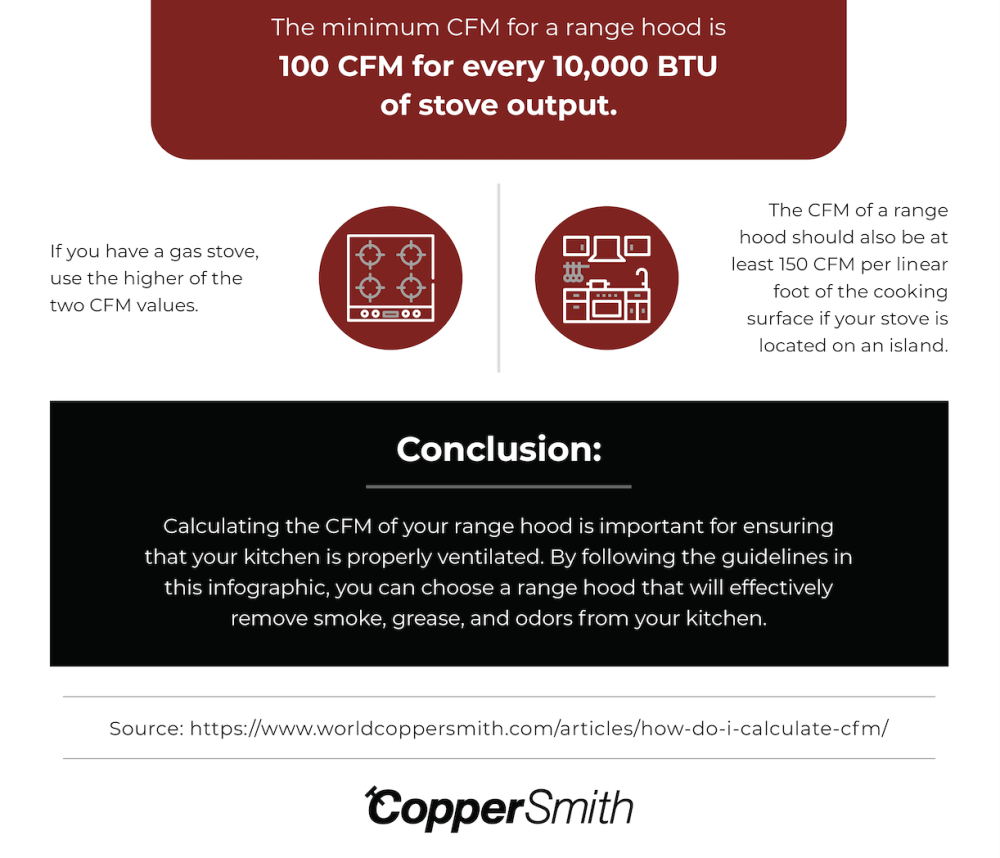
As well as CFM, what else should you consider when adding a range hood?
Technically, range hoods are not a requirement for all kitchens and are not always mandated by building codes. Some tiny kitchens, for example, just do not have the space for a range hood. However, if you are regularly cooking with lots of steam and oil, a range hood will make a massive difference to the way your kitchen looks, feels and smells. Even when you can’t see steam and smoke, the oil particles are still floating through the air, and the grease from your pots and pans will gradually begin to leave a less-than-desirable coating over time if you are not getting rid of the dirty air. If you are a serious chef, a pretty powerful range hood is highly recommended.
Where do I put the range hood in the kitchen?
A range hood should be placed behind or directly over the range to be effective, as the further away it is from the source of the particles and smell,s the less suction power will be delivered to where you need it. However, it is important to bear in mind that the air that the range hoods take in needs to be let out to somewhere, so it is recommended to put them on or near to an exterior wall. The shorter the distance the air has to move to get outside, the less powerful the range hood system needs to be to be effective. When you are installing your range initially, this is something you should consider to save on future energy, installation, and equipment costs.
The noise of the range hood
While a powerful oven hood can be a great idea, some range hoods from some manufacturers can sound like there is an airplane taking off in your kitchen every time you use it - and that can be more than a little irritating! Fortunately, while CopperSmith range hoods deliver big on power, the high-quality system and components mean noise is at a minimum, so you can enjoy cooking and eating in your kitchen in relative peace.
The style
Of course, you will want a over the range vent hood that integrates seamlessly in with the rest of your kitchen and resonates with your personal taste. Because of this, you will want to look at the various finishes available from CopperSmith - brass, stainless steel, and copper are some of the materials we use to create our high-quality range hoods. You will also want to consider the maintenance involved in keeping them clean and looking great. For example, over time, copper can develop a patina, where the hue changes a little. This is a completely natural phenomenon and can look amazing. However, if you would rather keep the brand new look, you will need to take steps to keep it that way, and for some people, this can be more maintenance than they want. If this is you, choose a different finish, like stainless steel or brass, both of which are available from CopperSmith.
You will also want to keep in mind the overall look of your kitchen - is it modern or traditional, for example? Will the range hood fit in with your home’s general architectural style? Also take into consideration how seamlessly you wat it to be integrated into your kitchen. Do you want it to big, bold and stand out? Choose something with unusual features and color to differentiate it from the rest of the kitchen decor and thus considering it on your planned kitchen renovation costs.
The cost of your Kitchen Range Hood
Like almost everything, the cost of your range hood can vary widely. The size, power, materials and other hood features can affect the cost. At CopperSmith, you have complete control over the design and the features that you include, meaning you have control over the pricing. Do your research so you can get a good idea of what to expect in terms of how much you will be spending, and do not forget to add installation costs into the equation. Fitting a range hood is a job best left to the experts!
It is worth it in the long run to spend more on a higher-quality range hood. You won’t have to spend more money on replacement parts down the line or replacing the hood altogether.
Conclusion
Calculating the CFM for kitchen exhaust is easy once you understand the basics. If you're unclear about what size or speed to purchase, it's always a good idea to consult a professional. They'll help you choose the right kitchen exhaust fan for your situation.
It's definitely better to do your homework and know the right CFM for your kitchen before making a financial investment than to rush and discover that you have the wrong thing in the end.
Now that you know how to calculate the CFM for your range hood, it's important to ensure that when you get one, you get the best.
Check out our high-quality kitchen exhaust products. If you have any difficulty with your calculations, feel free to contact us, and one of our technicians will be in touch.




